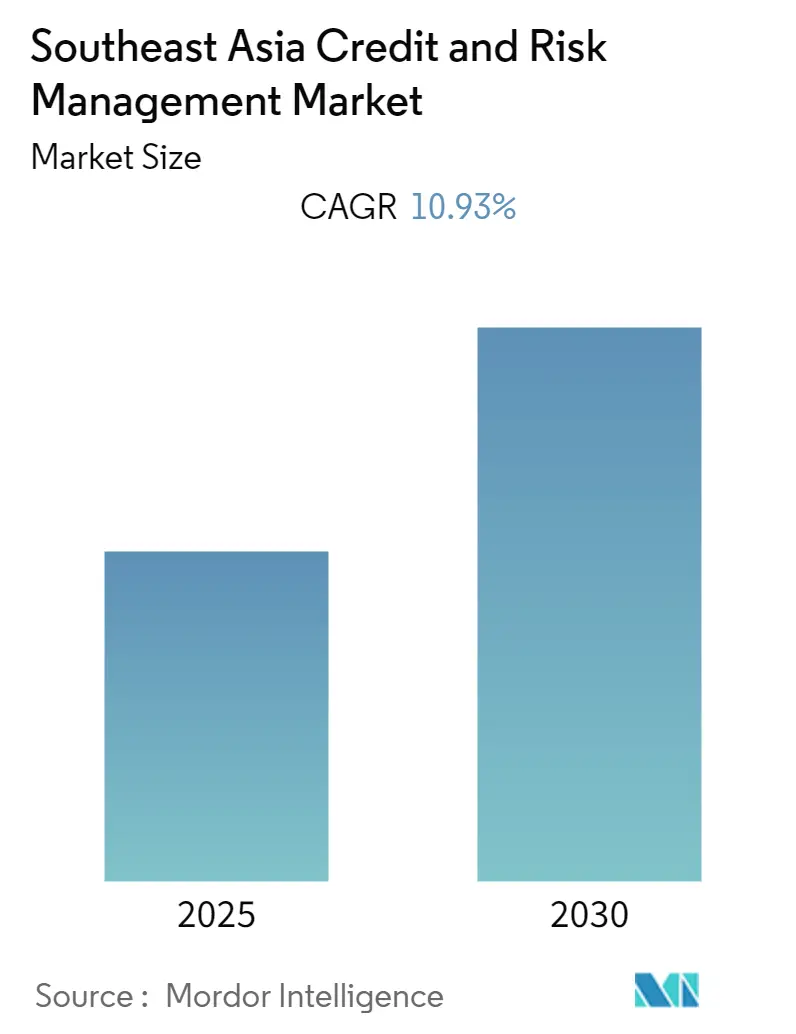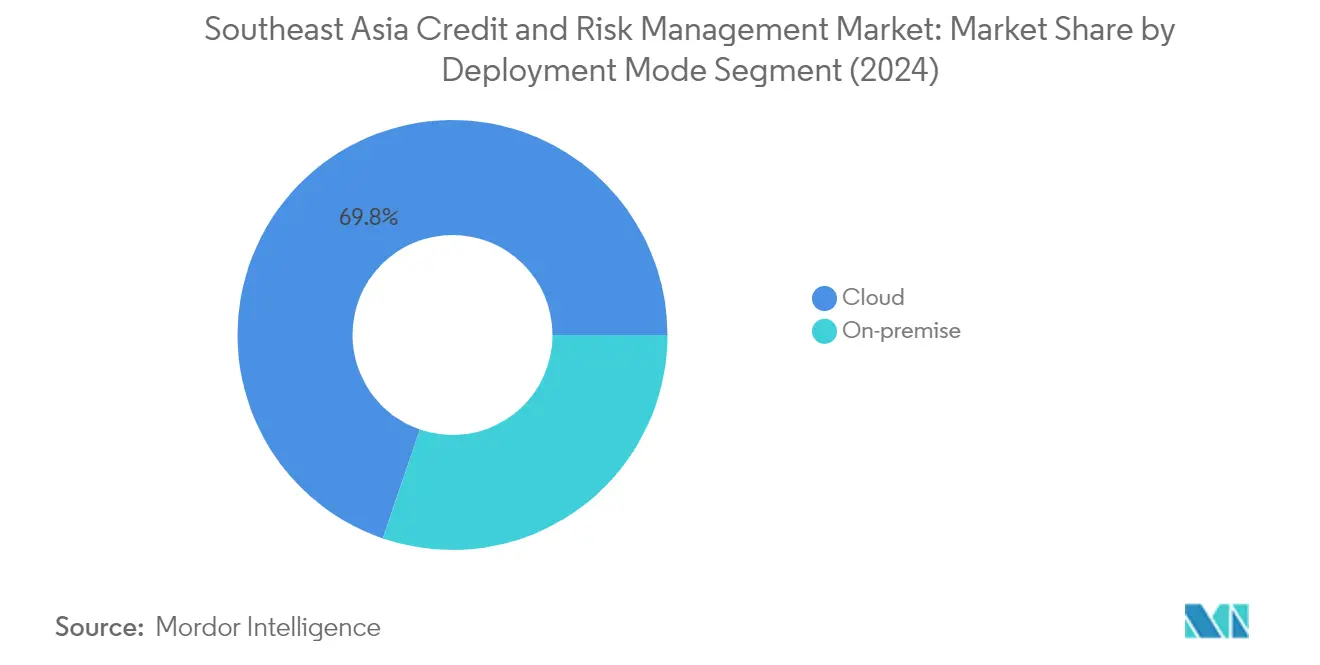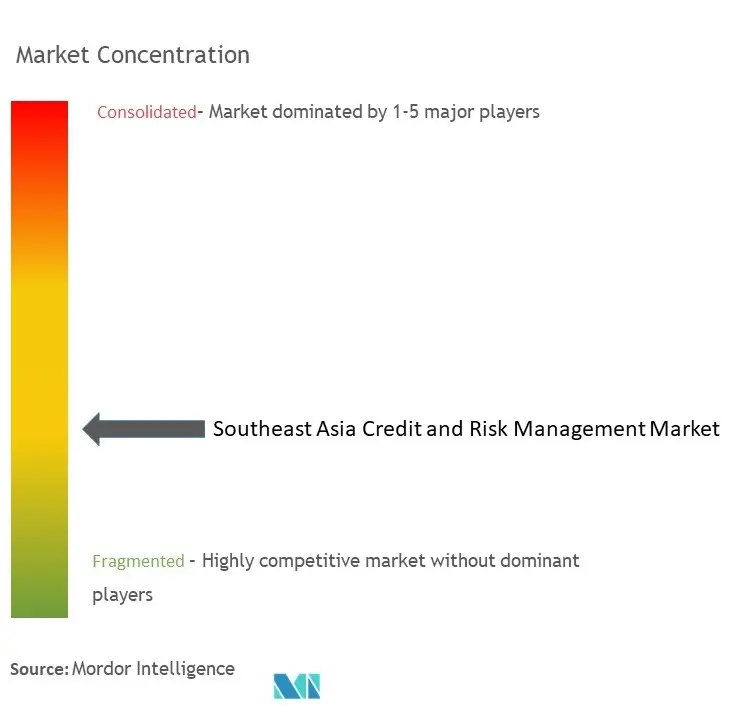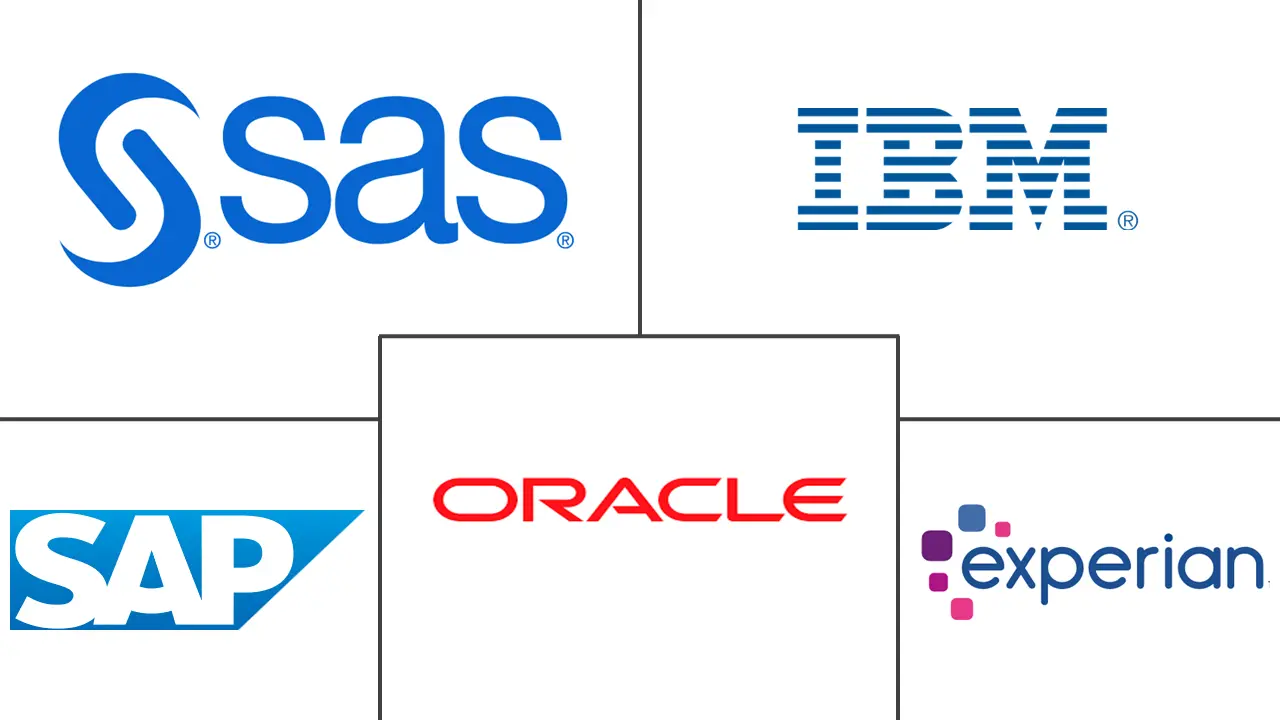Southeast Asia Credit and Risk Management Market Size and Share

Southeast Asia Credit and Risk Management Market Analysis by Mordor Intelligence
The Southeast Asia Credit and Risk Management Market is expected to register a CAGR of 10.93% during the forecast period.
The Southeast Asian credit and risk management landscape is experiencing a significant transformation driven by the rapid digitalization of financial services and the growing prominence of MSMEs in the region's economy. According to the Asian Development Bank, the SEA region hosts over 71 million MSMEs, which contribute an overwhelming 97.7% to private sector businesses, creating an unprecedented demand for sophisticated lending and credit risk management solutions. Financial institutions are increasingly adopting advanced analytics and artificial intelligence-powered systems to evaluate credit risk assessment, automate lending processes, and maintain robust risk monitoring mechanisms in response to this growing demand.
The integration of advanced technologies is reshaping traditional credit risk assessment methodologies across Southeast Asia's financial sector. Financial institutions are implementing AI-powered credit scoring systems that can analyze historical transaction patterns and payment behaviors to predict potential delays or defaults. This technological evolution is particularly evident in Thailand, where the National Credit Bureau (NCB) has announced plans to establish a digital non-credit data center by 2024, which will incorporate alternative data sources such as utility bills and telecom payments to enhance credit scoring capabilities for underserved borrowers.
The market is witnessing a significant shift toward digital banking solutions and financial inclusion initiatives across the region. Thailand's central bank has initiated plans to establish digital banks specifically designed to improve financial accessibility for underserved retail and SME clients. These digital banks are implementing automated lending processes supported by advanced credit risk management solutions, marking a significant evolution in the region's financial services landscape. The transformation is further exemplified by Credit Bureau Cambodia's report of 1.54 million loan accounts nationwide as of December 2022, demonstrating the growing penetration of formal lending services.
The industry is experiencing a notable trend toward the consolidation and standardization of risk data management practices while maintaining compliance with regional regulatory compliance frameworks. Financial institutions are investing in customizable solutions that can adapt to specific market needs while meeting strict regulatory requirements. This adaptation is particularly crucial as banks expand their digital services and cross-border operations, necessitating more sophisticated risk analytics tools. The trend is supported by strategic partnerships between financial institutions and technology providers, focusing on developing integrated platforms that combine traditional credit decisioning methods with innovative data analytics capabilities.
Southeast Asia Credit and Risk Management Market Trends and Insights
High Inflow of Credit Needs Owing to the Increase in Purchasing Power
The Southeast Asian region is experiencing a significant surge in credit demands driven by increasing purchasing power and robust economic growth across multiple sectors. Countries like Singapore and Malaysia have emerged as attractive destinations for global companies and investors, supported by sophisticated digital infrastructure and strong legal frameworks. Singapore's business ecosystem has developed extensively, featuring global R&D facilities for Fortune 500 companies alongside more than 150 venture capital funds, incubators, and accelerators. The introduction of a 15% minimum effective tax rate for multinational enterprises (MNEs) in Singapore from January 2025 further demonstrates the region's commitment to maintaining a structured yet attractive business environment that drives credit demand.
The growing presence of micro, small, and medium enterprises (MSMEs) has become a crucial factor in driving credit needs across the region. In Malaysia, SMEs serve as a fundamental component of the economy, contributing more than one-third of the GDP, with banking institutions providing over 90% of their total financing requirements. This trend is complemented by the expansion of multinational companies in various sectors, as exemplified by Yamaha Motor's establishment of a new robotics company in Singapore to serve the growing Southeast Asian and Indian markets. The increasing number of emerging businesses, particularly in sectors such as telecom, retail, and automobile, are actively expanding their operations and launching new products, creating additional demand for credit monitoring and risk mitigation solutions in the banking and financial services sector.
BFSI's Need to Diminish Bad Debt
The banking and financial services sector in Southeast Asia is intensifying its focus on reducing bad debt through improved financial risk management practices, which has become essential for the long-term success of banking institutions. When credit is extended to businesses that fail to repay, it creates significant challenges for commercial sector banks and financial institutions in the region. The implementation of credit and risk mitigation solutions enables banks to quickly and accurately calculate and manage critical risk while meeting regulatory requirements, thereby reducing the severity of financial losses and diminishing bad debt exposure.
Financial institutions across Southeast Asia are adopting more sophisticated approaches to credit assessment and enterprise risk management, particularly as they expand their lending portfolios to support economic growth. Banks are increasingly implementing integrated, quantitative credit and financial risk management solutions to reduce loan losses, minimize bad debt, and ensure that capital reserves appropriately reflect their risk profiles. These solutions offer numerous opportunities to digitize various manual processes and support banks and financial service providers in all aspects of their lending business. The trend is particularly significant as banks work to maintain asset quality while expanding their commercial and retail lending operations, with many institutions focusing on developing standardized credit underwriting frameworks and automated monitoring systems to identify potential defaults before they occur. Additionally, the adoption of advanced fraud detection techniques enhances the overall risk intelligence of financial institutions, safeguarding against potential threats.
Segment Analysis: By Deployment Mode
Cloud Segment in Southeast Asia Credit and Risk Management Market
The cloud deployment segment dominates the Southeast Asia credit and risk management market, holding approximately 70% market share in 2024. This dominance is driven by the increasing adoption of cloud-based solutions by financial institutions in the region. Risk management teams can swiftly and effectively combine various data sources and systems using cloud-based solutions, which feature conventional, user-friendly web-based interfaces without requiring complex setups between a bank's systems and third parties. Due to economies of scale, cloud providers can offer modern, secure cloud ecosystems that are significantly more robust than customers operating their own systems. The segment is also experiencing the fastest growth with around a 13% CAGR from 2024-2029, as many providers in the SEA market are offering cloud-native solutions and banks are adopting the SaaS model due to its scalability. This model optimizes the users' regulatory compliance process and allows them to manage regulatory capital and reporting needs in a timely and cost-effective manner. Additionally, the integration of risk analytics and credit risk software in cloud solutions enhances the ability of financial institutions to manage and mitigate potential risks effectively.

On-Premise Segment in Southeast Asia Credit and Risk Management Market
The on-premise deployment segment continues to maintain a significant presence in the Southeast Asia credit and risk management market, driven primarily by security concerns and data privacy requirements. This deployment method enables organizations to manage sensitive information stored in physical surroundings, providing complete control over data security and privacy protocols. The on-premise solution particularly appeals to financial institutions that require increased security measures and strict compliance with local regulatory frameworks. While the segment faces challenges from higher maintenance costs and significant upfront investments in infrastructure, many organizations, especially those dealing with highly sensitive financial data, continue to prefer this deployment model for its enhanced security features and direct control over system operations. The segment particularly benefits from its ability to provide customized solutions that can be tailored to meet specific organizational requirements and compliance needs. The integration of operational risk management and risk data management tools in on-premise solutions further supports institutions in maintaining robust security and compliance standards.
Southeast Asia Credit and Risk Management Market Geography Segment Analysis
Credit and Risk Management Market in Singapore
Singapore stands as Southeast Asia's premier financial hub, commanding approximately 35% of the region's credit and risk management market share in 2024. The country's banking sector has emerged as one of the strongest globally, supported by a stable economic environment and strict regulatory framework. The Monetary Authority of Singapore (MAS) governs over 150 deposit-taking institutions, ensuring robust credit risk analytics practices. The country's advanced digital infrastructure, coupled with its sophisticated legal system and deep talent pool, has attracted numerous global R&D labs and over 150 venture capital funds. Singapore's credit bureaus, including the Singapore Commercial Credit Bureau (SCCB) and Experian Credit Services, have implemented advanced analytics and AI-driven solutions to enhance credit scoring capabilities. The integration of Buy Now, Pay Later (BNPL) services and the appointment of specialized credit operators demonstrate the market's innovative approach to risk management. The presence of digital banks and their mandatory participation in credit reporting systems further strengthens Singapore's position as a leader in credit risk management solutions.
Credit and Risk Management Market in Indonesia
Indonesia's credit and risk management market is projected to grow at approximately 13% CAGR from 2024 to 2029, emerging as the fastest-growing market in Southeast Asia. The country's financial sector is undergoing rapid digital transformation, with PT Biro Kredit Indonesia Jaya (KBIJ) leading innovations in credit scoring methodologies. The integration of artificial intelligence and alternative data sources has revolutionized credit scoring mechanisms, enabling more accurate risk assessments for the underserved population. The Financial Services Authority (OJK) has implemented progressive regulatory frameworks that encourage digital adoption while maintaining financial compliance standards. Indonesian credit bureaus have expanded their services to include real-time credit monitoring, portfolio analysis, and automated decision-making systems. The market's growth is further supported by the increasing adoption of cloud-based credit assessment solutions and the emergence of innovative fintech partnerships. The focus on financial inclusion and the digitalization of credit processes has created a dynamic environment for credit risk management solutions, particularly in serving the country's vast MSME sector.
Credit and Risk Management Market in Malaysia
Malaysia's credit and risk management landscape has evolved significantly with the implementation of sophisticated digital solutions and regulatory frameworks. The country's credit ecosystem is anchored by prominent players like CTOS Data Systems and Experian Malaysia, who have introduced innovative credit assessment tools and AI-powered analytics platforms. The Bank Negara Malaysia's comprehensive financial compliance guidelines have created a structured approach to credit evaluation, particularly benefiting the SME sector, which contributes more than a third of the GDP. The integration of advanced technologies in credit scoring, coupled with the implementation of eKYC solutions, has streamlined the credit assessment process. Malaysian credit bureaus have established strategic partnerships with academic institutions and technology providers to enhance their analytical capabilities and develop more accurate credit risk models. The market's maturity is reflected in its comprehensive credit reporting infrastructure and the adoption of advanced predictive analytics for risk assessment.
Credit and Risk Management Market in Thailand
Thailand's credit and risk management sector has demonstrated remarkable advancement through its National Credit Bureau's innovative initiatives and technological adoption. The country's approach to credit risk management has been transformed by the implementation of digital non-credit data centers and alternative data sources for credit assessment. Thai banks have embraced sophisticated risk management tools to handle their expanding loan portfolios and maintain regulatory compliance. The market has witnessed significant developments in automated credit processing systems and real-time risk assessment capabilities. The integration of utility bill information and telecommunication data into credit assessment processes showcases Thailand's innovative approach to comprehensive risk evaluation. The collaboration between financial institutions and technology providers has resulted in more efficient credit decision-making processes and improved risk management frameworks. The market's evolution is further supported by the central bank's progressive policies on digital lending and risk assessment methodologies.
Credit and Risk Management Market in Other Countries
The credit and risk management landscape in other Southeast Asian countries, particularly the Philippines and Cambodia, demonstrates varying levels of market maturity and digital adoption. These markets are characterized by their unique approaches to credit risk assessment and management, influenced by their respective regulatory environments and financial sector development stages. The Philippines has focused on expanding financial inclusion through technology-driven credit assessment solutions, while Cambodia has implemented comprehensive credit reporting systems to support its growing financial sector. Both countries have witnessed increasing collaboration between traditional financial institutions and fintech companies in developing innovative credit risk management solutions. The markets share common trends in the adoption of digital technologies, cloud-based solutions, and AI-powered analytics for credit assessment. The ongoing digital transformation of financial services and the push for greater financial inclusion continue to shape the evolution of credit risk management practices in these emerging markets.
Competitive Landscape
Top Companies in Southeast Asia Credit and Risk Management Market
The market features established players like SAS Institute, IBM, Oracle, SAP, Experian, Moody's Analytics, and regional specialists like Integro Technologies. Companies are increasingly focusing on cloud-native solutions and AI-powered credit risk modeling tools to enhance their offerings, with many providers forming strategic partnerships with local technology consultants and financial institutions. The competitive landscape is characterized by continuous product innovation, particularly in areas of machine learning algorithms, automated credit scoring, and regulatory compliance solutions. Market leaders are expanding their presence through both direct operations and partner networks across Southeast Asian countries, while also investing in research and development to integrate advanced risk analytics capabilities. Strategic moves include acquisitions of local fintech companies, partnerships with digital banks, and development of customized solutions for the specific needs of emerging markets.
Consolidated Market with Strong Global Players
The Southeast Asian credit risk management market demonstrates a relatively consolidated structure dominated by global technology conglomerates and specialized risk management solution providers. These established players leverage their extensive experience in developed markets to serve the region's growing financial sector, while also adapting their solutions to meet local regulatory requirements and market conditions. The market witnesses regular strategic partnerships and acquisitions, particularly targeting local fintech companies and technology consultants who possess strong regional knowledge and established client relationships.
The competitive dynamics are shaped by the presence of both international players who bring advanced technological capabilities and local specialists who offer market-specific expertise. Market consolidation is driven by the need for comprehensive solution offerings that combine credit risk management, regulatory compliance, and advanced analytics capabilities. The barrier to entry remains high due to the complex nature of credit risk assessment technologies and the need for established relationships with financial institutions, leading to a market environment where strategic partnerships and technological innovation play crucial roles in maintaining competitive advantage.
Innovation and Localization Drive Market Success
Success in the Southeast Asian credit and risk management market increasingly depends on providers' ability to combine technological innovation with a deep understanding of local market conditions. Companies need to focus on developing cloud-based solutions that offer scalability and cost-effectiveness while ensuring compliance with regional regulatory requirements. The ability to provide customized solutions for different market segments, from traditional banks to emerging digital financial institutions, while maintaining a strong local presence through partnerships and support networks, has become crucial for market success.
Market players must address the growing demand for integrated enterprise risk management solutions while navigating the challenges of data security, regulatory compliance, and market-specific requirements. The concentration of banking and financial institutions in key markets creates opportunities for solution providers to establish long-term relationships, though this also intensifies competition. Regulatory changes across different Southeast Asian countries continue to influence market dynamics, making adaptability and compliance capabilities critical success factors. The low threat of substitution due to high switching costs and complex implementation requirements provides established players with competitive advantages, while new entrants must focus on niche segments or innovative technologies to gain market share.
Southeast Asia Credit and Risk Management Industry Leaders
SAS Institute Inc.
IBM Corporation
Oracle Corporation
SAP SE
Experian Information Solutions Inc.
- *Disclaimer: Major Players sorted in no particular order

Recent Industry Developments
- February 2023: Baiduri Bank, Brunei's leading financial services provider, partnered with Singapore-based AI FinTech Finbots.AI to modernize its credit risk management capabilities. Through this partnership, creditX, a finbots' cloud-based artificial intelligence credit modeling tool, can be used by the bank for credit scoring, optimizing the credit-decision process, resulting in increased operational efficiency.
- September 2022: Asian Development Bank's (ADB) investment and credit risk management policies, methods, tools, systems, and structure were evaluated to determine their applicability and effectiveness. To attain ADB's Strategy 2030 and broader development goals, the bank examined how risk management initiatives have been developed and performed to support PSOD's (Private Sector Operations Department) aims.
Southeast Asia Credit and Risk Management Market Report Scope
The credit and risk management market is defined based on the revenue generated from the software and services used in various industries. The scope of the study has been segmented based on the deployment mode (cloud-based and on-premises) across Southeast Asia.
The analysis is based on the market insights captured through secondary research and the primaries. The market study also covers the major factors impacting its growth in terms of drivers and restraints. The market sizes and forecasts are provided in terms of value (USD million) for the segments.
| Cloud |
| On-premise |
| By Deployment Mode | Cloud |
| On-premise |
Key Questions Answered in the Report
What is the current Southeast Asia Credit and Risk Management Market size?
The Southeast Asia Credit and Risk Management Market is projected to register a CAGR of 10.93% during the forecast period (2025-2030)
Who are the key players in Southeast Asia Credit and Risk Management Market?
SAS Institute Inc., IBM Corporation, Oracle Corporation, SAP SE and Experian Information Solutions Inc. are the major companies operating in the Southeast Asia Credit and Risk Management Market.
What years does this Southeast Asia Credit and Risk Management Market cover?
The report covers the Southeast Asia Credit and Risk Management Market historical market size for years: 2019, 2020, 2021, 2022, 2023 and 2024. The report also forecasts the Southeast Asia Credit and Risk Management Market size for years: 2025, 2026, 2027, 2028, 2029 and 2030.



